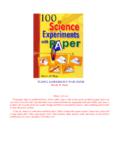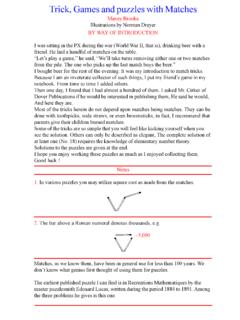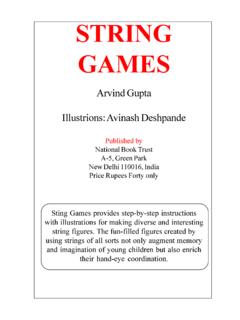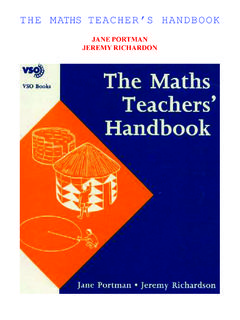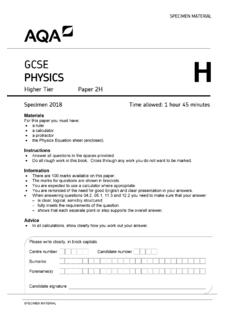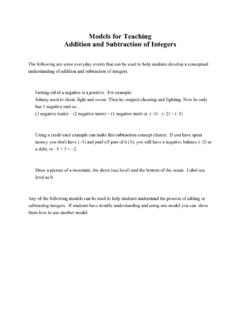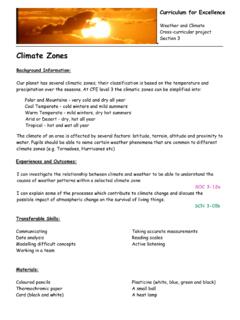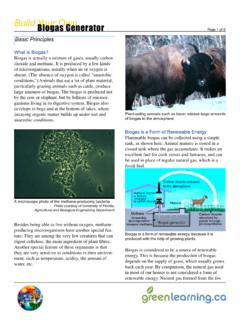Transcription of PHYSICS EXPERIMENTS FOR CHILDREN - Arvind Gupta
1 PHYSICS EXPERIMENTS FOR CHILDREN MURIEL MANDELLWhat better way is there to learn than by doing? This unusual book enables CHILDREN to carryout more than 103 different EXPERIMENTS and demonstrations, carefully planned to illustrateimportant principles of modern science. Clear step-by step instructions, frequent diagrams,clear statements of conclusions all enable the young student to carry through theseexperiments with minimal supervision, yet full success. The science projects included demonstrate what things are made of and how substancesare affected by the different forms of energy, heat, light, sound, mechanical energy,electricity and magnetism. The EXPERIMENTS show how a thermometer measures temperature,how an electric bulb gives light, how shadows are formed, holy a stethoscope works, howto make a periscope, how to make a rainbow, how straws work, how water changes size,and many other fascinating facts.
2 Little is required in the way of equipment other than simplematerials found at home, such as bottles, cardboard, wire, nails, cork, paper and magnets. This volume offers upper grade school, junior high school, and high school students a veryentertaining way to enrich their background in science and its applications. It is also a veryvaluable aid to parents, teachers, and others who wish to make clear, forcefuldemonstrations to CHILDREN . INTRODUCTION Science is a way of looking at things, a way of questioning and of figuring out answers bythinking, by trying them out (experimenting), and by reading about other people sexperiences and EXPERIMENTS . A scientist is a person who tries to understand and to find the answers to some of ourquestions about the physical world.
3 You too can be a scientist. To begin, don t take everything for granted. Start to questionthe world around you by performing the EXPERIMENTS in this book. Set aside a special corneror shelf for your odds and ends of equipment. Ordinary shoeboxes make good storagebins. You can perform the EXPERIMENTS safely by following directions and using simple care.(You can get burnt by drinking an ordinary cup of hot chocolate carelessly!) Theexperiments on electricity call for the use of storage batteries or dry cells. It is nevernecessary and it is dangerous to use house current. If you are not yet able to cook an eggover the stove, ask an older friend or adult to help you with those few EXPERIMENTS thatrequire a candle or other source of heat.
4 Always keep a basin of cold water handy. If an experiment fails to work, try it again and find out why it failed the first you can learn more from failure than from success. While you may start with an experiment from any chapter, it is best to concentrate on onechapter at a time and perform, most of the EXPERIMENTS , preferably in the order given, beforeyou go on to another topic. The EXPERIMENTS are not meant to be tricks with which to amazeyourself and your friends (though they may do that, tool), but to provide experiences and toillustrate scientific principles. The world of fact, you will find, can be more exciting than theworld of fancy. DOES AIR TAKE UP SPACE?1. MATTER: AIR CAN YOU FILL THE EMPTY BOTTLE?
5 Stuff a large handkerchief or some crumplednewspaper into an empty glass or jar. Make surethe handkerchief won t fall out when you turn theglass upside down. Then, fill a pot with water. Holding the glass sothat its mouth is down, put the glass deep into thepot of water and hold it there. After a minute ortwo, pull the glass out of the water and remove thehandkerchief. You will see that: The handkerchief is dry. Explanation: Water cannot fill the glass becausethe glass is already ~lled with air. The empty glass is full of air. So, air takes up space. Air is a gas. It has no size or shape of its own butwill fill every space it can. Place a funnel in the neck of an empty soda clay around the neck of the bottle so that there isno space between the bottle and the funnel.
6 Pour water into the funnel. Notice what happens. Then take the clay off the bottle and funnel. You will see that: While the clay is there, the waterremains in the funnel or enters the bottle only in slowspurts. When the clay is removed, the water flowsfreely into the bottle. Explanation: The clay seals the neck of the bottleoutside of the funnel. When water flows into thefunnel, the air cannot escape except by going throughthe water very slowly. The air in the bottle takes upspace and prevents the water from coming in. Whenthe clay is removed and air is able to leave around theneck of the bottle, then water can flow in. This provesthat air takes up space. DOES AIR WEIGH ANYTHING? WHICH IS HEAVIER, HOT AIR OR COLD?
7 Drill holes (or make notches) 6 inches from each end of a narrow 3-foot length ofwood, such as a yardstick. Then, make a hole in the exact center of the stick, 18 inchesfrom each end. Place a cord or wire through the center hole and suspend the stickfrom a chair back or a rod. Blow up a large balloon or beach ball. Tie its mouth tight and hang it from one of theend holes of the stick. Then, suspend a small can or box (such as a baking powdercontainer ) from the other hole. (See illustration.) Put a little sand or rice in the can untilthe stick balances. Then, let the air out of the balloon . You will see that: The can sinks down as the air is let out of the : When the air leaves the balloon , the balloon becomes lighter.
8 Air hasweight. At sea level, air weighs ounces per cubic foot. (See if you can find a carton, orstack up books, to measure 1 foot wide, 1 foot long and 1 foot deep. Then you willknow the space taken up by 1~ ounces of air. ) On a mountaintop, air is a little thinnerand weighs less. Balance an empty baby bottle on oneend of your yardstick and a tin can on theother. Put sand or rice in the can if needed. Hold a candle flame for one minute nearthe mouth of the bottle. Remove the flameand balance the scale again. You will see that: The bottle goes up whenheat is applied to the air in it. You mustremove sand or rice from the can on theother end to balance the scale. Explanation: Warm air weighs less thancold air occupying the same space.
9 WHAT HAPPENS TO WARM AIR? WHAT IS WIND? Rinse one jar with very cold water, andrinse another jar with hot water. Dry themboth thoroughly. With a cardboard between them, placethe jars mouth to mouth with the warmjar on the bottom. Ask someone to blowa puff of cigarette smoke into the bottombottle, as you lift the cardboard. Let thesmoke fill the bottom jar, and then pullout the cardboard. You will see that: The smoke will risefrom the lower to the upper jar. Explanation: The smoke rises as thewarm light air rises and the cold heavierair sinks. Try the experiment with thecold jar on the bottom and the warm oneon top. What happens this time? Sprinkle talcum powder on a cloth. Shake a littleof the powder off near a lamp with a light bulbwhich is not lighted.
10 Notice what happens to thepowder. Then light the bulb and give it a few minutes to gethot. Shake some more powder off the cloth. You will see that: Before the bulb is turned on, thepowder sinks slowly down through the air. After thebulb is hot, the powder rises. Explanation: When the air gets warmed by thelighted bulb, it rises, carrying the lightweight talcumpowder with it. The cooler heavier air is pusheddown. This flowing of cooler air to take the placeof hot air happens outdoors too. We know it aswind. AIR PRESSES IN ALL DIRECTIONS CAN AIR HOLD UP WATER? Cover the wide mouth of a funnel with a piece ofrubber from a balloon or from a rubber sheet. Tie therubber on tightly. Suck some air from the narrow end of the funnel andnotice what happens to the rubber.
